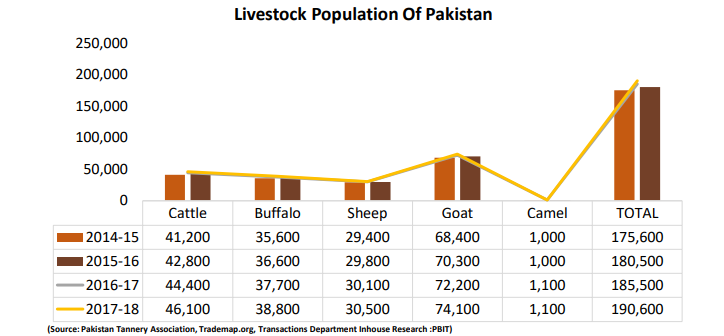
After textiles and vegetables, Pakistan’s leather industry, including value addition, ranks third in export revenue (sector as a whole). Over 800 tanneries in Pakistan are actively engaged in making the best quality finished leather from Cow, Buffalo, Sheep, and Goat skins. Thus, Pakistan is known as the center for producing high-grade leather and leather products.
Pakistan is rich in agricultural products and has a large livestock population which plays an important role in the economy of Pakistan by producing around 13.0 Million Hides and 47.4 Million Skins per annum (2015-16).
Report by Leather & Footwear News – Asia
Brief History of the Leather Industry in Pakistan

Only a few, highly small-scale tanneries were making sole leather at the time of independence. Some were established in Lahore and the surrounding areas in the 1950s. More units were installed in different regions of the country during the 1960s, including Multan, Sahiwal, Kasur, Gujranwala, and Sialkot. With the newest and most modern amenities, these units were well-equipped. In the 1970s, more modern facilities were set up, and Pakistan began producing finished leather. Furthermore, the 1980s were a time of higher-quality output. Thus, by contributing 10.41% of the nation’s total export revenue in 1990, the leather industry ascended to the position of second-largest earner of foreign exchange.
Cities of Pakistan Famous for Leather Production
Even though there are factories that make leather all over Pakistan, including in Kasur, Lahore, and Multan, over 90% of goods and clothing are produced in Karachi and Sialkot. Very few of these leather goods are marketed in the local market; almost all are exported. In Pakistan, there are more than 2500 tanneries, both registered and unregistered. The major cities with developed leather industries include Sialkot, Karachi, Kasur, Korangi, Gujranwala, Multan, Lahore, Faisalabad, Sahiwal, Hyderabad, and Peshawar. In the country, there are 784 leather units, 461 leather garment manufacturing units, 348 glove units, and more than 524 footwear units.
| Areas | No. of Leather Industries |
| Sialkot | 53 |
| Karachi | 44 |
| Lahore | 9 |
| Others | 5 |
Global Trends in the Leather Garment Industry
The leather products sector can be broadly divided into five categories: finished leather, leather gloves, leather footwear, and leather apparel (bags, wallets, and cardholders). With leather garment exports worth $422.1 million, $320.6 million, and $237.5 million, respectively, in 2020, Italy, India, and Pakistan are the top three exporters in the industry. However, the amount of such commodities being produced globally has been continuously decreasing over time, with a total export value of $2.3 billion expected in 2020.
Pakistan’s Principal Source of Raw Leather
1. Livestock
Pakistan is an agriculture-based country with the best cattle population in the world. According to Pakistan’s Federal Ministry of National Food Security & Research, there were 38.8 million buffalos, 46.1 million cattle, 74.1 million goats, 30.5 million sheep, and 1.1 million camels among the country’s livestock in 2017–18. As the population of animals has grown over time, this enables the leather market to gather more hides and skins. Pakistan’s overall livestock population increased by 8.5% during the course of four years, from 175,600,000 to 190,600,000 animals in 2017–18.

2. Hides & Skins of Animals
One of the top countries in the world for cattle production in Pakistan. In Pakistan, goat skin accounts for 50% of the total livestock population, while kid skin makes up about 23%. Also, similar to how buffalo hides account for 48% of all hides and 51% of all hides made up of cattle.


Leather Processing in Pakistan

The typical sources of raw materials for leather production are the cow, buffalo, goats, and sheep. Firstly, the tanning procedure includes a preparatory stage (Soaking, Liming, De-fleshing, De liming, Bating, and Pickling). Following the preparatory stage, the tanning stage begins, and many tanning techniques are typically used, including (Vegetable tanning, Aldehyde tanning, Synthetic tanning, and Chrome tanning). Then, post-tanning procedures include slamming, splitting, skiving, neutralizing, dyeing, greasin’, drying, and finishing come after the tanning stage. Finally, colors are applied to the leather’s surface to cover any scars or damage.
Pakistan’s Raw Leather & Leather Apparel Exporting Countries
Pakistan was the fourth-largest exporter of leather apparel in the world in 2020 with $588M in exports. Meanwhile, In the same year, leather apparel was Pakistan’s ninth-most-exported good. United States ($117M), Germany ($101M), Canada ($37.2M), Poland ($35M), and the United Kingdom ($26.9M) is Pakistan’s top export markets for leather clothing. Moreover, Pakistan receives its raw skin and hides from China, Kenya, Sudan, Saudi Arabia, and Tanzania. As a whole, major countries importing leather goods from Pakistan include Italy, Germany, France, the United States, Portugal, Singapore, the United Kingdom, Canada, Australia, Japan, Belgium, Spain, Korea, the Netherlands, Norway, Sweden, Mexico, Chile, Poland, Russia, Denmark, and South Africa.
Pakistan’s Raw Leather & Leather Apparel Importing Countries
Pakistan Imports of Raw hides and skins (other than furskins) and leather was US$43.53 Million during 2021.
United Nations COMTRADE database on international trade
Pakistan brought in $2.71M in leather apparel in 2020, ranking as the 82nd largest leather apparel importer globally. In Pakistan that same year, leather apparel ranked 700th in terms of imports. China ($1.06M), Germany ($417K), Turkey ($312K), the United States ($200K), and Spain ($166K) are the main countries from which Pakistan buys leather clothing. Moreover, Pakistan receives its raw skin and hides from Saudi Arabia, China, Kenya, Sudan, and Tanzania.
People Also Ask!
Which city is famous for the leather industry in Pakistan?
Although there are leather goods manufacturing plants all over Pakistan, Sialkot and Karachi have the highest concentration.
What is the price of leather in Pakistan?
The estimated price range for Pakistan Leather in 2023 is between US$ 5.32 and US$ 5.56 per pound or between US$ 5.32 and US$ 12.25 per kilogramme (lb). The cost is PKR 1804.62 per kg in Pakistani Rupees. Furthermore, In Lahore and Islamabad, the average cost per tonne is US$ 11730.02.
Why Pakistan is famous for leather & does pakistan have good leather?
About 800 tanneries in Pakistan are actively engaged in creating the best quality leather from cows, buffaloes, sheep, and goats. So, Pakistan is recognised as a hub for the manufacture of high-quality leather and leather products.
Final Thoughts
Comparing Pakistan’s leather garment export performance to that of its main rivals reveals that Pakistan’s leather garment exports outperformed the global average in both the ten-year CAGR (-4.83%) and the yearly growth rate (-8.17%). These growth rates surpass those of both India and Italy. Also, the Pakistani government supports the leather clothing business by removing import customs charges, increasing the duty drawback rates on leather clothing, lowering regulatory fees, and starting the Sialkot Tannery Zone project.
The industry has embraced the automation of customs procedures. Before the sector can once again prosper, though, there is still a tonne of work to be done. About 0.3 million people have employment prospects in the leather business, which also generates significant amounts of foreign exchange for the nation. Additionally, Pakistan’s livestock population assures a steady supply of raw materials for the leather industry. With all these advantageous circumstances, Pakistan’s leather sector ought should have grown and generated significant foreign exchange earnings for the country.

